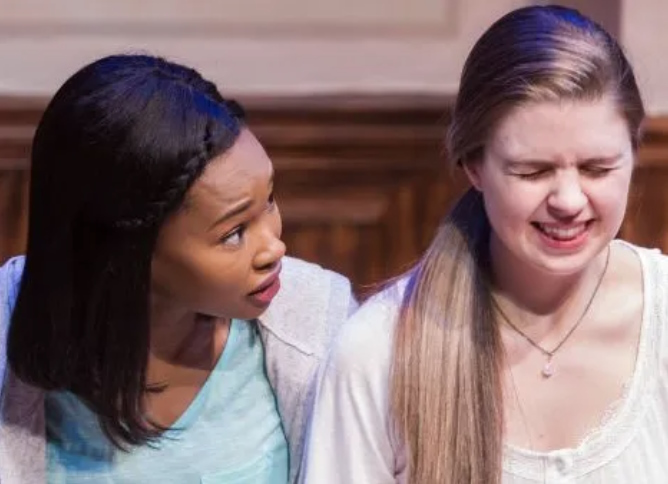Stacie Lents, author of COLLEGE COLORS, spent some time (in the middle of tech week!) with TRW discussing her thought-provoking play about friendship and change, her process of writing this play, and the importance (or necessity) of collaboration within theatre.
“I wanted to explore and question how we as individuals are impacted by this country’s history when it comes to prejudice, racism, homophobia–and what it means to be a friend in the face of that history.”
– Stacie Lents
KATIE STOTTLEMIRE: Your play COLLEGE COLORS is set in the same room for the entire play but highlights two pairs of roommates that lived there seventy years apart from each other. How did you come to create these specific characters and their relationships?
STACIE LENTS: I knew that I wanted to explore the questions of what has changed for us as a society and for young adults over time—and what hasn’t changed. At its heart, this is a play about friendship and about the aspirations and failures of friendship when it comes to addressing our own prejudice. I wanted to explore and question how we as individuals are impacted by this country’s history when it comes to prejudice, racism, homophobia–and what it means to be a friend in the face of that history. It seemed logical to explore two sets of characters at two different points in time because that allowed the two sets of actors/characters to be in dialogue with each other even when they’re not on stage together. But in terms of creating these characters, I had a lot of help; I owe a debt of gratitude to all of the actors who played these roles as they were very honest with me about what felt true to them. I was also very fortunate to develop this play initially at my own home university, Fairleigh Dickinson University, where the first brilliant cast of student actors had many conversations with me as I was writing about what is important to them as college students. Producer Marshall Jones III and actor Jasmine Carmichael were also invaluable advisors during the play’s development. Ms. Carmichael, who played Tanya in an early workshop, read several drafts of the play including the publication draft and took the time to offer feedback about the scenes, the dialogue.

KATIE: COLLEGE COLORS certainly explores how we as individuals are impacted by this country’s history, which is a very important aspect of storytelling. But, individuals are not the only ones impacted by change. In the past several years, we have seen a steep rise in social discourses that have led to the challenging of existing institutions and systems, including universities. Instead of showing what this looks like for a university at large, COLLEGE COLORS happens in the microcosm of a dorm room, keeping the experience of the individuals the center of this play. What led you to decide on a college campus, more specifically a dorm room, as the setting for COLLEGE COLORS?
STACIE: I like to approach playwriting from within specific points of view and circumstances. I hope that in doing so, the production gets to more universal truths, but I am most at home telling specific stories that I hope will resonate rather than putting my plays or my characters forward as representing a whole issue or group of people. I was interested in looking at a college campus in part because I myself have spent so much time on college campuses—as a student, a graduate student, a professor—and because college campuses are often the starting points for important cultural dialogue. For this particular story, I was looking at the history of colleges in this country and of the baggage that many of our oldest universities carry in terms of their relationship to diversity, equity, and inclusion. It was also really important to me as a White writer to put the White characters in the position of facing their own blind spots. I was interested in how larger cultural questions play out in the relationships—and specifically friendships and how we as people are sometimes blinded to our own ignorance. I can’t stress enough how fortunate I was to have the advice and perspective of the actors I worked with. I was also lucky in that Crossroads Theater, who produced the first professional production, helped me schedule interviews with some of the first Black students on some of these campuses.

KATIE: Working with others is vital to the work we do in the theatre industry. Based on this conversation, it seems like you were in constant dialogue with this play before it was finished. One moment that really sticks with the audience is in the final moments of the play when we see both sets of characters on stage together, although they are experiencing different moments in time. It’s a strong choice that results in an impactful image. Did you always know that the characters would all be on stage together at some point, or were they originally fated to exist separately?
STACIE: Yes and yes! The stories certainly started as separate ones, but I realized fairly early on in the writing process that I wanted to give the audience a chance to contend with these four characters at the same time so that as an audience, they could draw their own conclusions about the history of this fictional college and fictional dorm room. It was important to me to have characters on stage alongside their own history or their own future.
KATIE: Speaking of a character’s own history and future: for you, what does it mean to be a playwright? Has the meaning changed over the course of your life?
STACIE: The meaning has certainly changed, mostly because I continue to learn from every production I do and from the artists I work with. For example, playwriting meant something completely different for me before I began working with incarcerated actors through commissions from Prison Performing Arts. These actors taught me a lot about what it means to have a voice in the telling of your own story. I am less interested now in expressing a static story or point of view on stage and much more interested in asking the questions that touch my life and the lives of those around me. I am also much more reliant on other artists, particularly those who work on my plays, to collaborate with me on what is true and on the points of view of the characters. The longer I write, the less I know! I write to grapple with questions I don’t know the answers to and to question and examine my own point of view.
Read Stacie Lents’ Bio
Article by Katie Stottlemire
